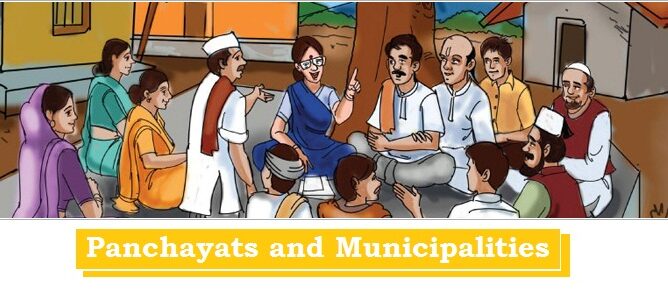
The history of Panchayati Raj starts from the self-sufficient and self-governing village communities. In the time of the Rig-Veda (1700 BC), evidence suggests that self-governing village bodies called ‘sabhas’ existed. With the passage of time, these bodies became panchayats (council of five persons).
The village panchayat, as a system of administration, began in the British days, as their offer to satisfy the demands for local autonomy. They opened up the governance of the lowest levels to the citizens. The Government of India Act, 1935 also authorizes the provinces to enact legislations.
However, the foundation of the present local self-government in India was laid by the Part IX: 73rd and 74th Constitutional Amendment Act 1992 (Panchayati Raj System). It did not get adequate importance in the Constitution due to:
- The turmoil due to the Partition resulted in a strong unitary inclination in the Constitution. Nehru himself looked upon extreme localism as a threat to unity and integration of the nation.
- There was a powerful voice in the Constituent Assembly led by Dr. B.R. Ambedkar which felt that the faction and caste-ridden nature of rural society would defeat the noble purpose of local government at the rural level.
Panchayats
- Part IX (Art 243) added via 73rd Constitutional Amendment Act 1992 with a new 11th Schedule to the Constitution.
- It realizes Art 40 of DPSP i.e: Organisation of village Panchayats, constitutionalizing rural local self-govt to build grass root level democracy.
- It transfers the representative democracy into participatory democracy by the transfer of authority from central to local government (‘Decentralization’).
- Though, it is a Central law on a State subject, the States are also given adequate discretionary powers with regards to local self governance.
Salient features:
- Gram Sabha- foundation of Panchayati Raj System
Gram Sabha is a village assembly consisting of all the registered voters in the area of Panchayat - Three- tier system of Panchayati Raj System:
2015 (02)
Panchayats at village, intermediate (block) and district levels. - Directly elected bodies:
All members to be elected directly by the people. Chairpersons of Intermediate and district level Panchayats to be elected indirectly by the elected members (Village Panchayat as determine by the State legislature). - Reservation:
Reservation of seats at all levels for ST/SCs in proportion of their population, 33% for their women (Reservation to office of chairperson may be determined by the State Legislature including for OBCs) - 5 year term for each Panchayat:
5 Year term office for Panchayat at each level. If dissolve, fresh elections to be held within 6 months. - Qualifications:
21 years (unlike 25 years for State Legislature) with others same as that for State Legislature
Financial autonomy:
- The State legislature may authorize a Panchayat to levy taxes, duties, tolls, etc
- Assign to Panchayats taxes, duties collected by the State (As recommended by Finance Commission of State)
- Provide for Grant-in-aid from Consolidated Fund of State (as recommended by Finance Commission)
PESA ACT 1996
Objectives:
- To extend the provisions of Part IX of the Constitution in Schedule Areas with modifications
- To evolve a suitable mechanism of local governance consistent with the tribal customs
ALERT: The Municipal Extension to Scheduled Areas Act (MESA) was introduced in Parliament but was never passed. Govt is accused of converting a rural area into urban to nullify the provisions of PESA especially in land acquisition.
Features:
- Gram Sabha:
- Every village shall have a Gram Sabha consisting of persons in the electoral rolls
- Gram Sabha shall approve the plans and programs before being taken up for implementation by GPs
- Gram Sabhas or Panchayats shall be consulted before making land acquisition for developmental activities.
- Reservation:
- Reservation as per the population with STs not less than 50% seats
- Chairpersons of Panchayats at all levels reserved for STs
- State Govt may nominate STs with no representation in the Intermediate or District Panchayats, which shall not exceed 1/10th of total membership
- Local resources:
- Recommendation of GS or Panchayats mandatory for mining lease for minor minerals
- Ownership of minor forest produce
- Traditional Customs:
- Power to regulate sale of intoxicant, money lending activities
- Power to manage village markets
- Following Sixth Schedule:
- State Govt to follow the pattern of Sixth Schedule in the administrative mechanism at District Level Panchayats
Municipalities
Part IXA (Art 243) added via 74th Amendment Act 1992 with a new Twelfth Schedule in the Constitution.
Salient Features:
- Three types of municipalities:
- Nagar Panchayat: for a transitional area (from rural to urban)
- Municipal Council: for a smaller urban area
- Municipal Corporation: for a larger urban area
- Directly elected bodies:
- All members to be elected directly.
- Each municipal is divided into territorial constituencies called as ‘Wards’.
(State May provide the manner of the election of chairpersons)
- Reservation: Same as Panchayats
- Duration: Same as Panchayats
The act also provides for some constitutional institutions:
State Election Commission:
- The act also provides for a State Election Commission for superintendence, direction, and conduct of all elections of Panchayats and Municipalities.
- It
is independent of Election Commission of India and consists of a State Election
Commissioner appointed by the Governor.
(Though cannot be removed by him, but in like manner as that of a HC Judge)
Finance Commission for State:
- The act also provides for a Finance Commission for State to be constituted by the Governor after every 5 years
- To review the financial position of the Panchayats and municipalities and to recommend the principle of distribution of taxes and grant-in-aids to them by the State.
- The Governor is to place the Report of the Commission along with the action taken report before the State Legislature.
- The Central Finance Commission also suggests the measures to augment the Consolidated Fund of the State to supplement the resources of Panchayats and municipalities.
District Panning Committee:
- A District Planning Committee to consolidate the plans of the Panchayats and the Municipalities in the district and to prepare a plan for the district as a whole.
- 4/5 members of the Committee are elected by the District Panchayat and the Municipalities among themselves. The State Legislature may provide other provision related to the committee.
- The Chairperson forwards the District Development Plan to the State Govt.

 Home
Home Syllabus
Syllabus Contact Us
Contact Us





2 thoughts on “Panchayats and Municipalities”